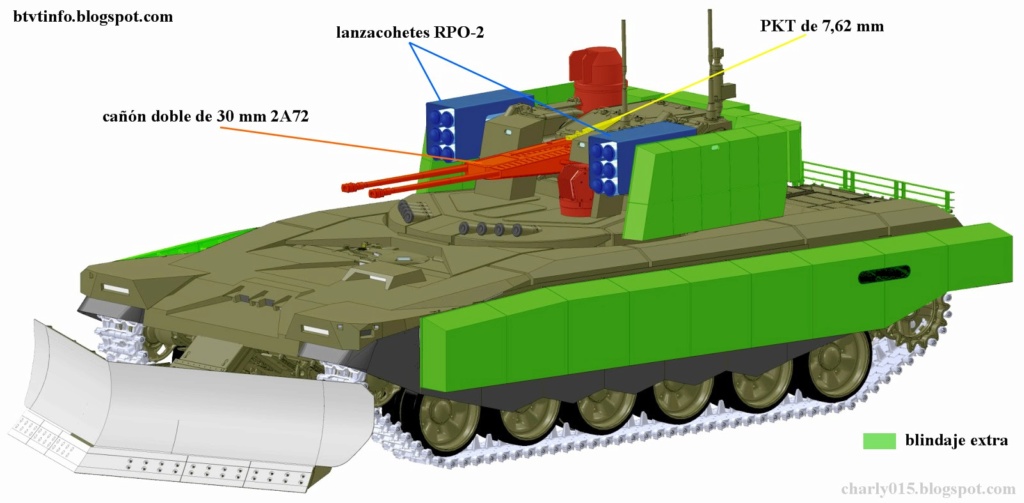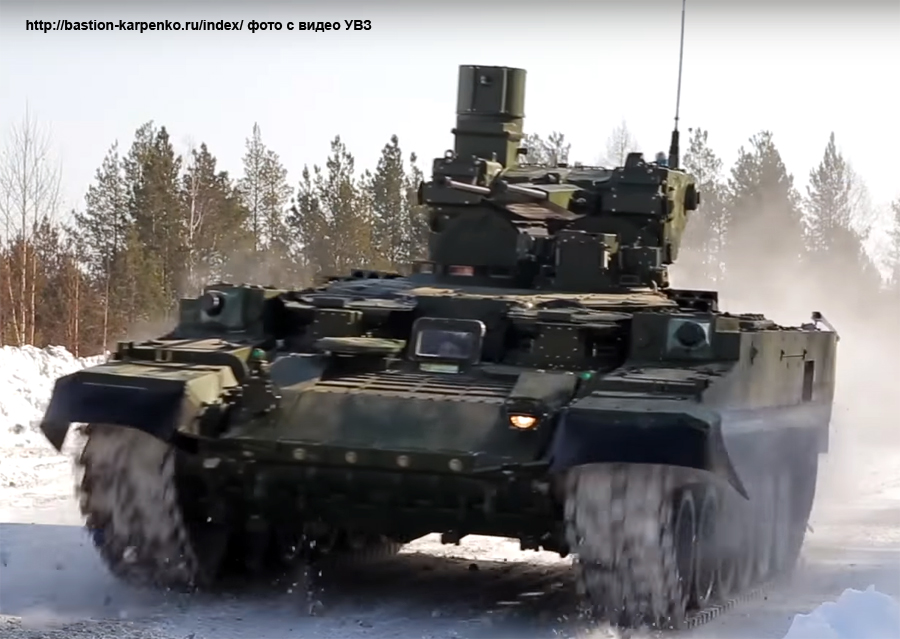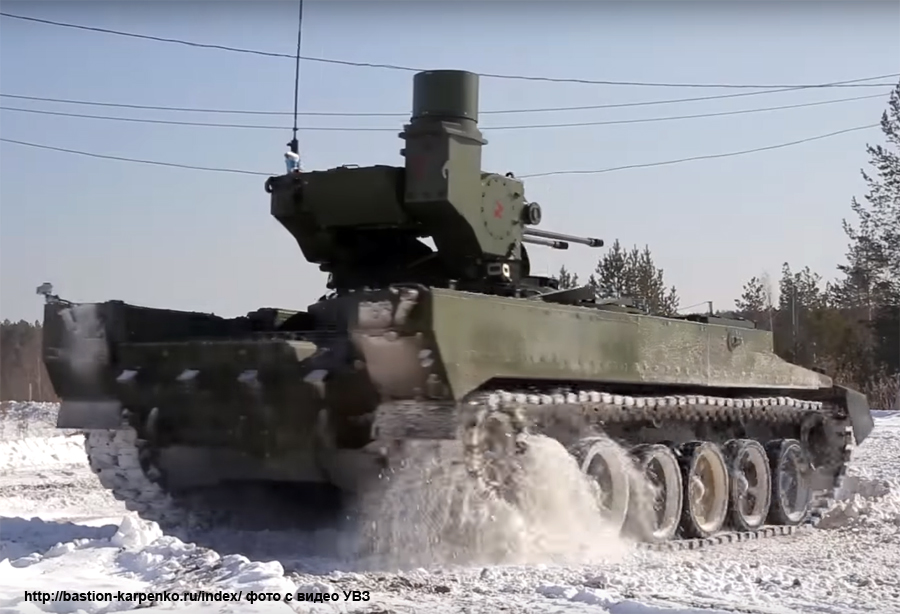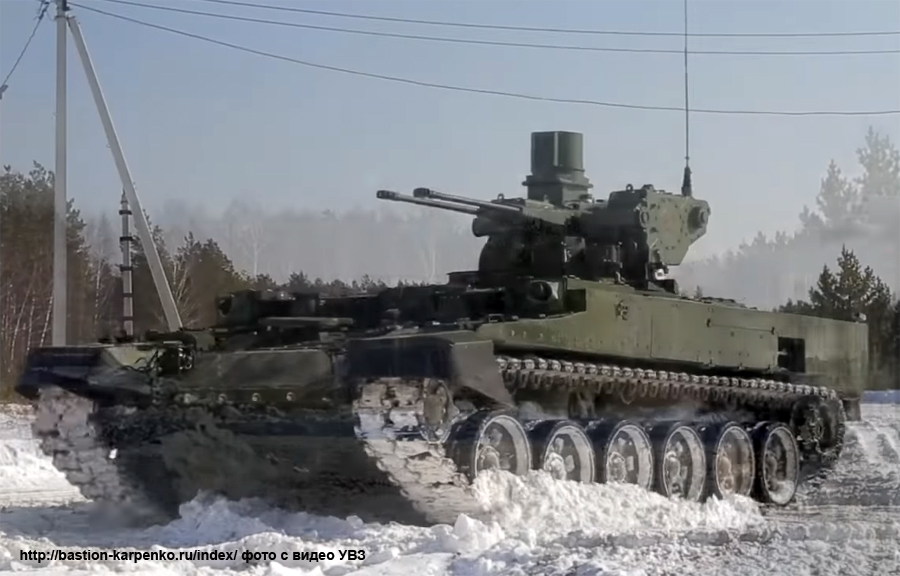 GarryB Sun Jan 05, 2020 6:08 am
GarryB Sun Jan 05, 2020 6:08 am
It would be interesting to see a MBT like a T-90 remade with a smaller gun in an unmanned turret for places where enemy heavy armour is rare and could be handled with a Kornet instead of a main gun round, so main gun ammo can consist mostly of HE frag for direct fire fire power against infantry positions and bunkers.
Perhaps a 57mm high velocity main gun that could effectively deal with any vehicles from armour IED platforms right up through previous generation BMPs and BTRs like warriors and M113s etc, together with a low velocity long range deliverer of HE like a 40mm grenade launcher and perhaps a 23x115mm calibre model of the KPV hmg for targets that don't require a 57mm round.
With a remote weapon station attached to the commanders optics that can fire rifle calibre machine gun ammo and of course a rifle calibre machine gun coaxially mounted next to the main gun there should be onboard space for enormous amounts of ammo in enough variety to engage a variety of threats and targets... perhaps with two pods on top for either Kornet or Bulat or unguided rockets like RPO/RPG type rounds or aircraft rockets of the 57mm, 80mm and 122mm calibre...
Of course it could be argued that in such a situation a better main gun would actually be the 100mm rifled gun of the BMP-3 because it has more HE power, though it probably only has half the range (7km vs about 12km), but packs more punch and probably doens't take up much more room inside the tank because the shells are all projectile with a small stump of propellent, but in such a case you would want a high velocity weapon to compliment the low velocity high capacity HE round... and rather than trying to squeeze a 57mm gun on there as well I would probably go for a 30mm cannon... though I might be tempted to go for a single twin barrel cannon as fitted to the Hind and the Frogfoot for rate of fire. The entire turret bustle could be filled with 30mm cannon shells in enormous numbers... say... 2,000 rounds, and a box on top with 300 x 40mm grenades for a rear roof mounted 40mm grenade launcher that is fixed in traverse with the turret but can elevate like the 30mm grenade launcher on the BMP-2 upgrade.
The BMP-3 can carry 40 x 100mm shells in its autoloader so in this much larger turret with no crew positions inside I would expect more than double that could be carried because they are relatively small rounds... so a double ring of 100mm rounds with perhaps 90 shells and the space inside the ring where the crew in the BMP normally sit could hold coaxial machine gun ammo in enormous volumes.
Perhaps fit the twin barrel 30mm cannon to the side of the turret elevating independently from the 100mm gun with its ammo feed directly from the turret bustle holding perhaps 2,000 round of 30mm rounds.
The 100mm main gun centrally position in the front of the turret with a rifle calibre machine gun and a 23x115mm KPVB single barrel gun mounted coaxial either side with their ammo stored in the crew locations... 1,500 x 23mm rounds and 5,000 rifle calibre rounds, and a rear central turret mount for a 40mm grenade launcher with a 400 round ammo pack scabbed on top of the turret. One pod of rockets/missiles holding either four Kornets, 8 Bulat missiles, or rocket pods of various other types of ground and aircraft carried rockets... On the 360 degree optics for the commander a rifle calibre machine gun which has its own ammo stored around the rear part of the optical mount that turns with the optics and holds about 1,500 rounds.
With miniature optics and slim weapons like the PKT and the 40mm grenade launcher being quite compact I would be tempted to go back to the multi turret tank designs of the 1930s... back then they were awkward to control efficiently and made the vehicle huge with extra people and reduced armour because of these factors, but with a central system management having a couple of small flat turrets that sat at a lower level than the main turret you could effectively engage multiple targets at one time... suppressive fire is important and if it is all properly aimed it is much more effective and if it is from below armour it can be properly aimed.
One of the models of the BMPT actually had positions half way down the hull with weapons where the operators sat behind the turret in hull positions operating side facing weapons.
Properly designed flat remote weapon stations should allow a broad arc of fire while still being able to use the main weapons on the central turret... the problem of course is cost... and in action target management.
Normally with a tank the gunner just engages the target he is instructed to engage by the commander, it is the commander who looks for threats and for targets and decides which gets engaged... for instance if he detects an M1 Abrams tank and a Bradley, if the vehicle has ARENA and Shtora, he will likely instruct the driver to turn the frontal armour towards the Abrams and the gunner to open fire on the Abrams while he monitors the Bradley... perhaps instructing the driver to move the tank so the Abrams can be engaged but the bradley is not visible and then when the Abrams is destroyed direct the gunner to engage the bradley and the driver to move to the bradley is visible but nothing else is...
For a BMPT the targets of interest will be different and likely much more plentiful... the BMPT commander will mark the abrams and the bradley on his map for the local tanks to engage, but will most likely concentrate on troop positions and other vehicle types to engage... targets that do not require heavy weapons to engage can be handed off to the bow grenade launcher positions, while the gunner takes on threatening targets like an ATGM team using cannon.
The gunners manning the separate RWSs might be engaging drones or MG positions or sniper positions, or just spraying an enemy infantry line to suppress them while friendly infantry move forward...
Of course these days land drones with machine guns and light cannon and grenade launchers could also contribute too...







 Isos
Isos

